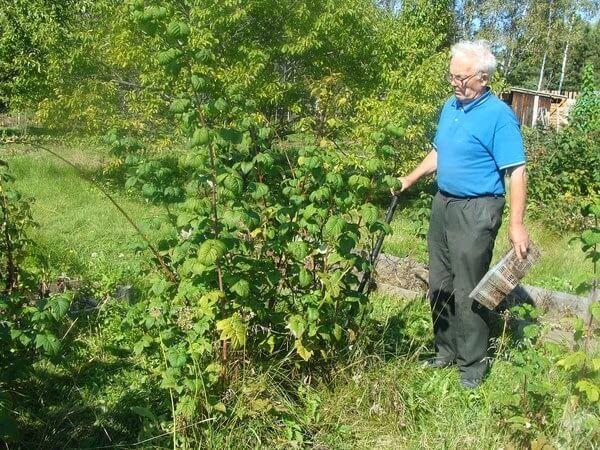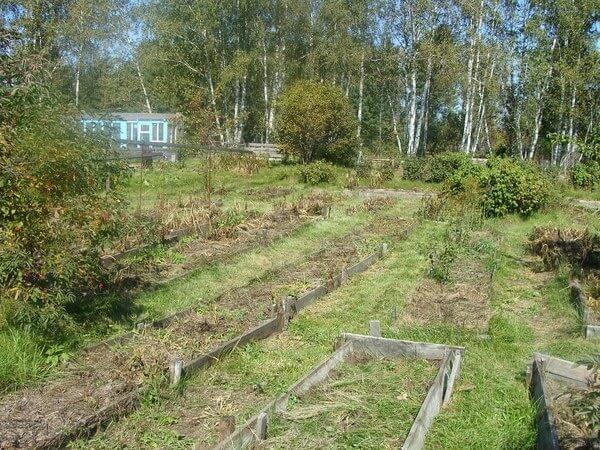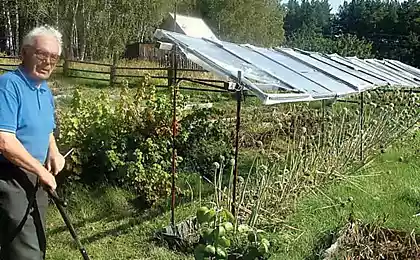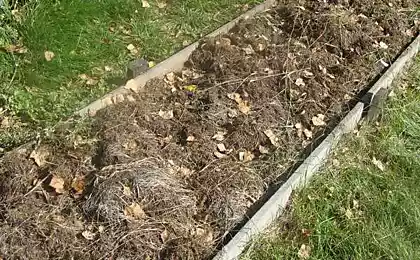649
SMART GARDEN Zamyatkina - 2000 kg with a weave!
Ivan Parfentevich Zamyatkin noticeable personality in the Krasnoyarsk Territory. Due to the results of the application of its variants reasonable Agriculture Ivan Parfentevich in difficult climatic conditions the area has achieved results that are in all cultures they ask, if not in the Guinness Book of Records, the Russian list of records.
In recent years, only for its potato crops held steady at the level of 2000 kg with a weave (in terms of hectare - 2000 kilograms per hectare).
Since then, and began his interview with Ivan Parfentevich the letters and responses of farmers. We think that to get acquainted with the arguments of the national experimenter will be interesting.

Not at all turns. In the early years, until the soil is alive, "wakes up" from the "hangover" as a result of long-term poisoning with chemical fertilizers and pesticides, the annual destruction of its natural horizons plow - it may still not be enough loose, especially if it contains little humus (less than 3, 5%), severe, intermittent. In these cases it is very good organic mulch, slotting, for example, with plane Fokine. In subsequent years, the soil itself for optimal plant density and porosity.
- Should we consolidates the soil before sowing green manure? As the seed is? Do I need to be watered? In the spring before planting vegetables whether it is necessary to dig? Beveled spring rye bury or leave on the surface as mulch?
If this is not a commercial secret, is it possible to learn more about your technology? The main points are clear: not to plow permanent track, work with plane. And the nuances on the crests? Watering? Planting depth? Needless to spud? The distance between the holes?
- What's the "secret"! All this is a long time ago and repeatedly published in many periodicals and books. But, apparently, it does not reach to the understanding of the essence, the consciousness. Maybe we are too incurious, accustomed to a rut?
- I have to disagree with your technology. I puzzled: how to plant and sow especially for not dig up? Do you offer a lot of green green manure mixed with the upper 8-10-cm layer of soil. But then loosen the soil? Sow on the "dirty" a flower bed? Planting potatoes on beds - an invention may, and favorable (higher harvest), but I have never met such. Please answer.
- Respond in detail as possible, but whether it is necessary to detail too publicly any experience? Not because it is a "trade secret", so that the field and garden - no factory floor, and wildlife at each site its own terms. Someone soil - entirely sand, in other pools do not dry out until June, the northern and southern slopes, in the forest, under the Igarka or, conversely, in the Khakass, Tuva dry steppes, in some rich black earth, while others - a bog, sour, saline or alkaline soil, peat, rocks, someone near the forest obscures the light, etc. etc. Do I have one in every detail with a diversity of terms to describe, and the other copy someone else experience?
IN AND. Blokhin from Vladivostok writes that sow green manure after harvesting potatoes. Oats, rape gave a lot of good in here rye somehow rarely risen, rape is also not shown. And the reason is the same: a mechanical copying of Southern Siberia technology in Primorye. The conditions of these regions strikingly similar, so a set of crops and agricultural machinery can not be the same. Even in the neighboring fields or areas may not be exactly the same technology. It is more important to deeply understand the idea of the meaning of natural farming system. The rest, as they say, a matter of technique, creativity, taking into account local conditions and circumstances. No need to go blindly on occasion, for example, stringent techniques of the American preacher himizirovannyh narrow beds D. Mitlaydera or at least as stringent and too himizirovannyh Dutch technologies. Not suitable they are for all occasions, in all conditions. This is also clearly spoken and numerous failed attempts to impose a single technology for all areas, such as agricultural systems with a turnover of formation or application of chemicals solid, square-hill planting corn, beans ...
We must strive to better understand the biological characteristics of plants, local soil and climatic conditions. Without theoretical knowledge and skills to take into account local conditions such results are unthinkable. But the owners of sites that require detailed instructions, usually even have no idea what kind of soil they have, the parameters of the local climate, especially recognized varieties, etc. Anyway, none of this does not report any writings or lectures. What doctor will take to treat a patient, never seeing him in the eyes and not knowing the diagnosis?

- Ridge - this is understandable. And without plowing - also understandable. But completely without fertilizer? It is not clear how to grow green manure. You can sow potatoes in, and then pull out and are buried in the ground?
- True noticed actor-humorist, if everything is clear, you're not well informed. Narrow beds, tramlines, no plowing, sowing green manure, crop rotation, mulching in organic agriculture are closely linked. This single system does not use in the first place of chemical fertilizers and pesticides. And the nature of something is just "plow" and "cleans".
The task of the farmer - in every possible way to help soil microorganisms, worms, and other inhabitants of the soil, abundant feed them organic, for example, in the form of mulch, planting green manure, crop residues, etc.
And sow the potatoes do not need anything, especially in the wells, this culture is very light, does not tolerate closeness. Green manure in a potato field is better to grow before planting (rye), or after harvest of early varieties (rape, mustard, rape, oilseed radish, mallow, Phacelia, beans, etc.).
In the context of South Siberia green manure can be sown after the harvest of the main early crops (onions, radishes, etc.) On the same beds, without plowing and digging, usually in July and August. Before the frost in late October, they manage to collect 100-300 kg of green mass on weaving, which is equivalent to the same amount of litter manure. You can grow them and in early spring before planting seedlings of vegetables, potatoes and other heat-loving crops. The main thing - the ground of snow to the snow should not remain bare
. Green manure at the start of flowering is better not to plow, and to cut off just below the root collar or tillering node ploskorez or sharp spade and left on the surface in the distance as mulch. On very poor soils it is advisable to take a green manure separate beds for the whole summer. It turns out like a pair of green manure.
In the cottages and gardens better in this case not to sow clover, as do the production workers in arid areas, and plants with more intensive photosynthesis and therefore growth, giving to 1000-1500 kg / ha of green mass. Because I tested this artichoke, amaranth, sunflower, corn, payza, sweet sorghum and other crops.
In recent years, only for its potato crops held steady at the level of 2000 kg with a weave (in terms of hectare - 2000 kilograms per hectare).
Since then, and began his interview with Ivan Parfentevich the letters and responses of farmers. We think that to get acquainted with the arguments of the national experimenter will be interesting.

Not at all turns. In the early years, until the soil is alive, "wakes up" from the "hangover" as a result of long-term poisoning with chemical fertilizers and pesticides, the annual destruction of its natural horizons plow - it may still not be enough loose, especially if it contains little humus (less than 3, 5%), severe, intermittent. In these cases it is very good organic mulch, slotting, for example, with plane Fokine. In subsequent years, the soil itself for optimal plant density and porosity.
- Should we consolidates the soil before sowing green manure? As the seed is? Do I need to be watered? In the spring before planting vegetables whether it is necessary to dig? Beveled spring rye bury or leave on the surface as mulch?
If this is not a commercial secret, is it possible to learn more about your technology? The main points are clear: not to plow permanent track, work with plane. And the nuances on the crests? Watering? Planting depth? Needless to spud? The distance between the holes?
- What's the "secret"! All this is a long time ago and repeatedly published in many periodicals and books. But, apparently, it does not reach to the understanding of the essence, the consciousness. Maybe we are too incurious, accustomed to a rut?
- I have to disagree with your technology. I puzzled: how to plant and sow especially for not dig up? Do you offer a lot of green green manure mixed with the upper 8-10-cm layer of soil. But then loosen the soil? Sow on the "dirty" a flower bed? Planting potatoes on beds - an invention may, and favorable (higher harvest), but I have never met such. Please answer.
- Respond in detail as possible, but whether it is necessary to detail too publicly any experience? Not because it is a "trade secret", so that the field and garden - no factory floor, and wildlife at each site its own terms. Someone soil - entirely sand, in other pools do not dry out until June, the northern and southern slopes, in the forest, under the Igarka or, conversely, in the Khakass, Tuva dry steppes, in some rich black earth, while others - a bog, sour, saline or alkaline soil, peat, rocks, someone near the forest obscures the light, etc. etc. Do I have one in every detail with a diversity of terms to describe, and the other copy someone else experience?
IN AND. Blokhin from Vladivostok writes that sow green manure after harvesting potatoes. Oats, rape gave a lot of good in here rye somehow rarely risen, rape is also not shown. And the reason is the same: a mechanical copying of Southern Siberia technology in Primorye. The conditions of these regions strikingly similar, so a set of crops and agricultural machinery can not be the same. Even in the neighboring fields or areas may not be exactly the same technology. It is more important to deeply understand the idea of the meaning of natural farming system. The rest, as they say, a matter of technique, creativity, taking into account local conditions and circumstances. No need to go blindly on occasion, for example, stringent techniques of the American preacher himizirovannyh narrow beds D. Mitlaydera or at least as stringent and too himizirovannyh Dutch technologies. Not suitable they are for all occasions, in all conditions. This is also clearly spoken and numerous failed attempts to impose a single technology for all areas, such as agricultural systems with a turnover of formation or application of chemicals solid, square-hill planting corn, beans ...
We must strive to better understand the biological characteristics of plants, local soil and climatic conditions. Without theoretical knowledge and skills to take into account local conditions such results are unthinkable. But the owners of sites that require detailed instructions, usually even have no idea what kind of soil they have, the parameters of the local climate, especially recognized varieties, etc. Anyway, none of this does not report any writings or lectures. What doctor will take to treat a patient, never seeing him in the eyes and not knowing the diagnosis?

- Ridge - this is understandable. And without plowing - also understandable. But completely without fertilizer? It is not clear how to grow green manure. You can sow potatoes in, and then pull out and are buried in the ground?
- True noticed actor-humorist, if everything is clear, you're not well informed. Narrow beds, tramlines, no plowing, sowing green manure, crop rotation, mulching in organic agriculture are closely linked. This single system does not use in the first place of chemical fertilizers and pesticides. And the nature of something is just "plow" and "cleans".
The task of the farmer - in every possible way to help soil microorganisms, worms, and other inhabitants of the soil, abundant feed them organic, for example, in the form of mulch, planting green manure, crop residues, etc.
And sow the potatoes do not need anything, especially in the wells, this culture is very light, does not tolerate closeness. Green manure in a potato field is better to grow before planting (rye), or after harvest of early varieties (rape, mustard, rape, oilseed radish, mallow, Phacelia, beans, etc.).
In the context of South Siberia green manure can be sown after the harvest of the main early crops (onions, radishes, etc.) On the same beds, without plowing and digging, usually in July and August. Before the frost in late October, they manage to collect 100-300 kg of green mass on weaving, which is equivalent to the same amount of litter manure. You can grow them and in early spring before planting seedlings of vegetables, potatoes and other heat-loving crops. The main thing - the ground of snow to the snow should not remain bare
. Green manure at the start of flowering is better not to plow, and to cut off just below the root collar or tillering node ploskorez or sharp spade and left on the surface in the distance as mulch. On very poor soils it is advisable to take a green manure separate beds for the whole summer. It turns out like a pair of green manure.
In the cottages and gardens better in this case not to sow clover, as do the production workers in arid areas, and plants with more intensive photosynthesis and therefore growth, giving to 1000-1500 kg / ha of green mass. Because I tested this artichoke, amaranth, sunflower, corn, payza, sweet sorghum and other crops.























